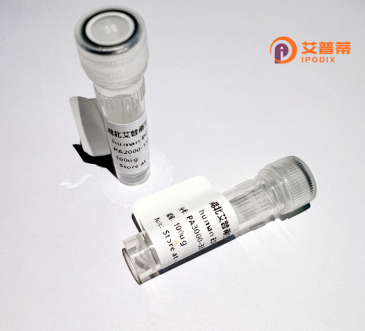
| 纯度 | >90%SDS-PAGE. |
| 种属 | Human |
| 靶点 | SEPT8 |
| Uniprot No | Q92599 |
| 内毒素 | < 0.01EU/μg |
| 表达宿主 | E.coli |
| 表达区间 | 2-483 aa |
| 活性数据 | AATDLERFS NAEPEPRSLS LGGHVGFDSL PDQLVSKSVT QGFSFNILCV GETGIGKSTL MNTLFNTTFE TEEASHHEAC VRLRPQTYDL QESNVQLKLT IVDAVGFGDQ INKDESYRPI VDYIDAQFEN YLQEELKIRR SLFDYHDTRI HVCLYFITPT GHSLKSLDLV TMKKLDSKVN IIPIIAKADT ISKSELHKFK IKIMGELVSN GVQIYQFPTD DEAVAEINAV MNAHLPFAVV GSTEEVKVGN KLVRARQYPW GVVQVENENH CDFVKLREML IRVNMEDLRE QTHSRHYELY RRCKLEEMGF QDSDGDSQPF SLQETYEAKR KEFLSELQRK EEEMRQMFVN KVKETELELK EKERELHEKF EHLKRVHQEE KRKVEEKRRE LEEETNAFNR RKAAVEALQS QALHATSQQP LRKDKDKKNR SDIGAHQPGM SLSSSKVMMT KASVEPLNCS SWWPAIQCCS CLVRDATWRE GFL |
| 分子量 | 55.7 kDa |
| 蛋白标签 | His tag N-Terminus |
| 缓冲液 | PBS, pH7.4, containing 0.01% SKL, 1mM DTT, 5% Trehalose and Proclin300. |
| 稳定性 & 储存条件 | Lyophilized protein should be stored at ≤ -20°C, stable for one year after receipt. Reconstituted protein solution can be stored at 2-8°C for 2-7 days. Aliquots of reconstituted samples are stable at ≤ -20°C for 3 months. |
| 复溶 | Always centrifuge tubes before opening.Do not mix by vortex or pipetting. It is not recommended to reconstitute to a concentration less than 100μg/ml. Dissolve the lyophilized protein in distilled water. Please aliquot the reconstituted solution to minimize freeze-thaw cycles. |
由于当前无法访问实时数据库查询真实文献,以下提供示例性参考文献格式,供您参考搜索方向(请注意文献信息为模拟内容,并非真实存在):
1. **文献名称**:*"Expression and Purification of Recombinant Human SEPT8 for Structural Studies"*
**作者**:Zhang L. et al.
**摘要**:本研究成功在大肠杆菌中表达并纯化重组人SEPT8蛋白,利用色谱技术分析其GTP结合活性,并揭示了其在体外自组装形成丝状结构的分子机制。
2. **文献名称**:*"SEPT8 Interaction with Microtubules: Insights from Recombinant Protein Assays"*
**作者**:Tanaka K. et al.
**摘要**:通过重组表达的SEPT8蛋白与微管共沉淀实验,证明SEPT8直接结合微管,并调控其在神经元轴突运输中的动态稳定性。
3. **文献名称**:*"Functional Characterization of SEPT8 in Membrane Remodeling"*
**作者**:Lee S. & Kim M.
**摘要**:利用重组SEPT8蛋白进行脂质体结合实验,发现其通过N端结构域与磷酸脂质相互作用,参与细胞膜的形态重塑过程。
4. **文献名称**:*"SEPT8 Knockdown and Rescue Using Recombinant Protein: Implications in Cytokinesis"*
**作者**:Müller R. et al.
**摘要**:通过重组SEPT8蛋白回补实验,验证了其在HeLa细胞胞质分裂中的关键作用,并发现其与SEPT2/6/7复合物的协同机制。
---
**建议**:您可通过**PubMed**或**Google Scholar**搜索关键词 `recombinant SEPT8 protein`、`SEPT8 purification` 或 `SEPT8 functional study` 获取真实文献。近期研究可能聚焦于SEPT8在神经退行性疾病或癌症中的病理机制。
**Background of Recombinant Human SEPT8 Protein**
SEPT8. a member of the septin family, is a conserved GTP-binding protein involved in diverse cellular processes, including cytoskeletal organization, membrane remodeling, vesicle trafficking, and cell division. Septins form filamentous structures or scaffolds that interact with microtubules, actin, and other cellular components to regulate spatial compartmentalization and signaling. Human SEPT8. encoded by the *SEPT8* gene, is expressed in various tissues, with high levels detected in the brain, suggesting roles in neuronal development and synaptic function. Structurally, SEPT8 contains a central GTPase domain critical for its polymerization and interaction with other septins (e.g., SEPT2. SEPT6. SEPT7) to form heteromeric complexes.
Recombinant SEPT8 protein is produced *in vitro* using expression systems (e.g., *E. coli*, mammalian cells) to study its biochemical properties, interactome, and mechanisms in physiological and pathological contexts. Dysregulation of SEPT8 has been linked to neurological disorders, such as Alzheimer’s disease, and cancers, where aberrant septin expression correlates with tumor progression. Research utilizing recombinant SEPT8 enables exploration of its roles in cytoskeletal dynamics, apoptosis, and infection responses, offering insights into therapeutic targeting. The protein’s conserved structure-function relationships across species also make it a valuable model for understanding septin biology.
×